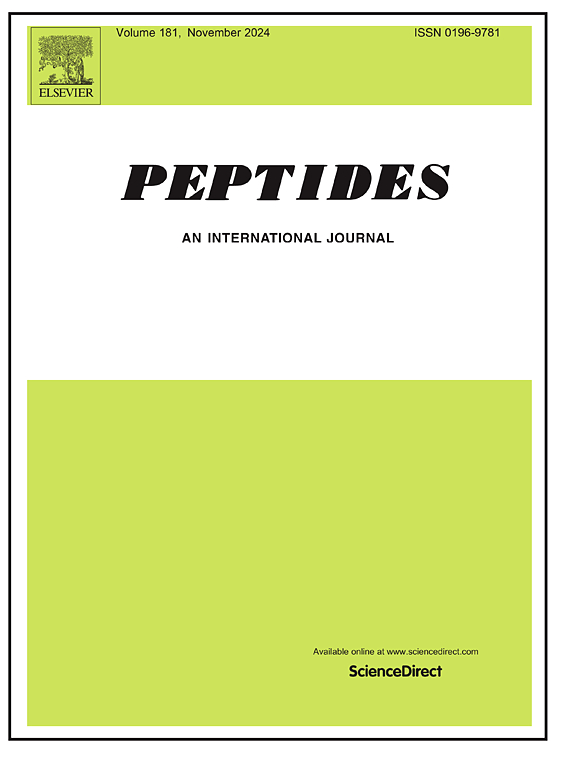Cholecystokinin - portrayal of an unfolding peptide messenger system
IF 2.9
4区 医学
Q3 BIOCHEMISTRY & MOLECULAR BIOLOGY
引用次数: 0
Abstract
This review describes how the classic gut hormone, cholecystokinin (CCK), should be comprehended in 2025. In the early physiological tradition of studying gastrointestinal hormones, the hormones were named after the function that lead to their discovery. Hence, in 1928, the hormonal factor in the upper gut that regulated gallbladder contraction was called cholecystokinin. In 1968, Viktor Mutt and Erik Jorpes identified the porcine structure of this factor as an O-sulfated and carboxyamidated peptide of 33 amino acid residues (CCK-33). Its C-terminal bioactive heptapeptide amide turned out to be homologous to that of the antral hormone, gastrin. The structure allowed in vitro synthesis of peptide fragments for physiological studies and for production of CCK-antibodies for immunoassays and immunohistochemistry. Today, these tools have revealed CCK to be highly complex: CCK is a heterogenous, multifunctional peptide messenger system, widely expressed both in and outside the gut. Thus, the CCK gene encodes six different bioactive peptides (CCK-83, −58, −33, −22, −8, and −5) that are expressed in a cell-specific manner in O-sulfated and non-sulfated forms. Moreover, CCK peptides are not only hormones. They are also potent neurotransmitters, paracrine growth and satiety factors, anti-inflammatory cytokines, incretins, potential fertility factors and useful tumor-markers. Moreover, CCK has a phylogenetic history of nearly 600 million years. Particular interest has been given to the neuroscience of CCK, because CCK is the predominant peptide transmitter in the brain, expressed in amounts that surpass any other neuropeptide. Vice versa, the brain is the main production site of CCK in mammals.
胆囊收缩素-展开肽信使系统的写照
这篇综述描述了在2025年应该如何理解经典的肠道激素——胆囊收缩素(CCK)。在研究胃肠激素的早期生理学传统中,激素是以导致它们被发现的功能来命名的。因此,在1928年,调节胆囊收缩的上肠激素因子被称为胆囊收缩素。1968年,Viktor Mutt和Erik Jorpes发现该因子的猪结构是由33个氨基酸残基(CCK-33)组成的o -硫酸化和羧化肽。其c端生物活性七肽酰胺被证明是与胃窦激素胃泌素同源的。该结构允许体外合成肽片段用于生理研究和生产cck抗体用于免疫测定和免疫组织化学。今天,这些工具揭示了CCK是高度复杂的:CCK是一种异质的多功能肽信使系统,在肠道内外广泛表达。因此,CCK基因编码六种不同的生物活性肽(CCK-83、- 58、- 33、- 22、-8和- 5),这些肽以细胞特异性的方式以o -硫酸盐和非硫酸盐形式表达。此外,CCK肽不仅仅是激素。它们也是有效的神经递质、旁分泌生长和饱足因子、抗炎细胞因子、肠促胰岛素、潜在的生育因子和有用的肿瘤标志物。此外,CCK具有近6亿年的系统发育历史。由于CCK是大脑中主要的肽递质,其表达量超过任何其他神经肽,因此对CCK的神经科学特别感兴趣。反之亦然,哺乳动物的大脑是CCK的主要产生部位。
本文章由计算机程序翻译,如有差异,请以英文原文为准。
求助全文
约1分钟内获得全文
求助全文
来源期刊

Peptides
医学-生化与分子生物学
CiteScore
6.40
自引率
6.70%
发文量
130
审稿时长
28 days
期刊介绍:
Peptides is an international journal presenting original contributions on the biochemistry, physiology and pharmacology of biological active peptides, as well as their functions that relate to gastroenterology, endocrinology, and behavioral effects.
Peptides emphasizes all aspects of high profile peptide research in mammals and non-mammalian vertebrates. Special consideration can be given to plants and invertebrates. Submission of articles with clinical relevance is particularly encouraged.
 求助内容:
求助内容: 应助结果提醒方式:
应助结果提醒方式:


